Customer Experience (CX) Transformation: A Guide To Success

On this page:
What is Customer Experience Transformation?
Definition and Importance
Customer experience transformation is a customer-centric strategy aimed at improving every single experience a customer has with a brand. That means reimagining these experiences at each step along the journey—from first interaction all the way through post-purchase care.
However, this transformation is not just about improving customer satisfaction. It’s all about getting your customer experience (CX) strategies aligned with your broader business objectives to drive tangible outcomes.
When companies make CX a top priority, they experience higher levels of customer retention and advocacy, ultimately leading to greater lifetime loyalty.
In an era where time is more valuable than ever, customer experience transformation is imperative. Ongoing iteration is critical, as the bar is always raised over and over again by increasingly impatient consumer expectations.
The process needs constant reinvention and evolution to stay ahead of these changing expectations. By prioritizing CX, you’re setting a foundation for enduring success and creating a loyal customer base that advocates for your brand.
Modern Business Relevance
The digital economy calls for businesses to prioritize customer experience in order to survive and thrive. Social media and online reviews can be very persuasive, and their influence can make or break a brand.
There’s no doubt that the COVID-19 pandemic has accelerated the shift in consumer behavior. Today’s customers expect more meaningful, responsive experiences that cater to their individual preferences.
To remain relevant and competitive, businesses need to undergo CX transformation. It means investing in technologies, including AI.
In fact, 60% of CX leaders think it will be a game changer for customer experience in the next few years. Employees are a crucial part of this transformation, needing the right training and support to truly drive better customer experiences.
Demonstrating the return on investment (ROI) from customer experience (CX) improvements is important. That’s because it helps them to win the resources and budget allocations necessary to thrive.
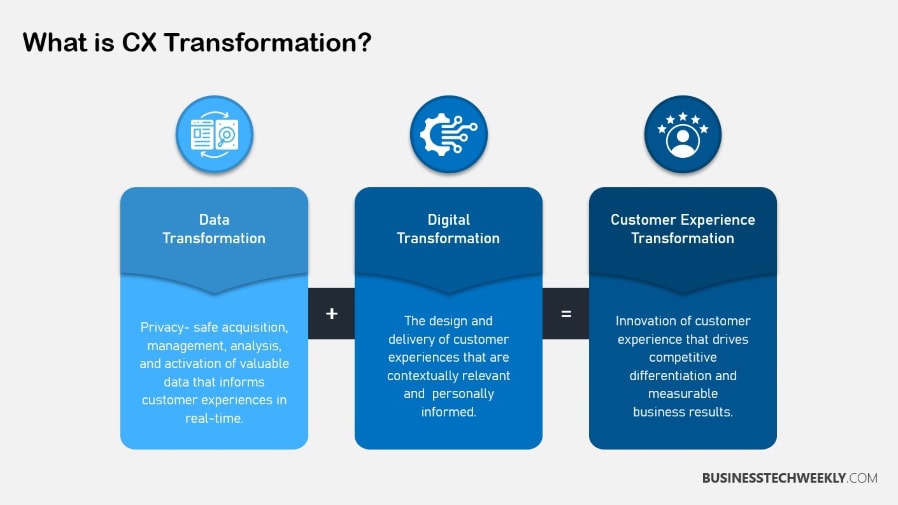
Key Benefits of CX Transformation
Boost Customer Loyalty and Retention
Creating deep customer loyalty is closely tied to improving customer experiences. When you intentionally build an atmosphere of belonging and genuine care, customers don’t leave. Think about your neighborhood coffee shop that remembers your go-to drink.
Now imagine a different kind of bookstore that recommends books based on your past purchases. It’s these personal touches that go a long way.
Personalized experiences are more relevant and engaging, helping you stay top of mind with your customers.
By consistently measuring customer satisfaction, you can identify which areas need work and implement a proactive approach that keeps customers coming back. Loyalty programs that incentivize return visits are another key factor.
They foster deeper, more emotional connections, which are an important part of lowering customer attrition and growing a list of loyal customers.
RELATED: Customer Journey Mapping: The Foundation of a Strong Omnichannel Strategy
Enhance Brand Reputation
Providing positive customer experiences helps to create a consistently authentic brand image. Think about the last time you made a service decision based on customer feedback testimonials and reviews.
Brands that can showcase those successful experiences using customer stories, no less, build themselves a stronger CX reputation. Keeping a pulse on brand sentiment using social listening tools can help organizations respond to negative feedback before it gains traction.
When a brand aligns their brand messaging with customer values, it reinforces emotional connections, which increase loyalty. In a competitive landscape, standing out is all the more simple when your brand aligns with customers’ values.
A good reputation does more than bring in potential new customers; it makes current customers become brand advocates.
Increase Revenue and Growth
Great customer experiences are directly tied to higher sales conversion rates. A thoughtfully architected experience can string together all the touchpoints to lead a customer from discovering your brand to making a purchase seamlessly.
When you know customers’ behaviors and insights, opportunities for upselling and cross-selling become more apparent. Marketing campaigns that focus on the distinct experiences you offer will draw customers to your destinations.
By tracking these revenue growth metrics, you will measure CX transformation’s real bottom-line benefits.
Prioritizing customer experience in the digital economy ensures businesses emerge stronger, ready to navigate modern consumer behavior complexities.
Considering that 60% of CX leaders expect AI to have a major impact, companies that get ahead of this transformation can create huge momentum.
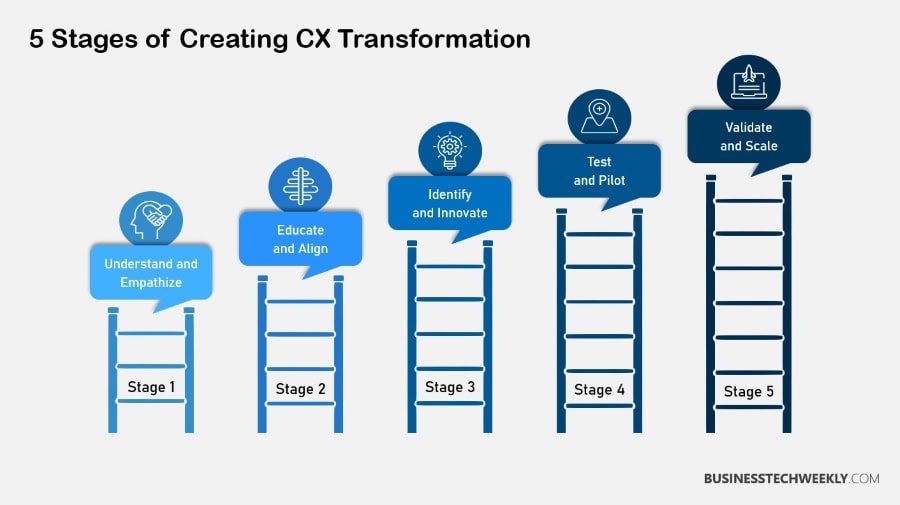
Steps to Implement Customer Experience (CX) Transformation
To implement a CX Transformation, as with any broad transformation, it’s important to start small but have a clear, organized plan with measurable actions in place.
First, ensure you have a solid baseline of where you are with the customer experience, which means doing full audits of current touchpoints.
Surveys, interviews, and focus groups are great tools for understanding the customer journey, developing touchpoint customers experience, and identifying pain points. Create customer journey maps to visualize customer touchpoints and identify realistic targets for improvement based on industry benchmarks.
1. Evaluate Current Customer Experience
Conduct a deep dive into all touchpoints of the customer experience to identify where you can improve. Conduct discovery via surveys and interviews to understand their experiences.
Create visual representations of experiences with journey maps; these are useful tools to identify problem areas that need attention.
Benchmarking against industry standards is integral to ensuring targets are realistic and attainable.
2. Set Clear Objectives and Goals
Establish specific, measurable, attainable, relevant, time-bound (SMART) objectives that support wider business objectives. This is critical to making sure you have a cohesive strategy.
Communicate these goals organization-wide to encourage an aligned approach.
Regularly revisit them, so that you can continually adapt and evolve based on customer feedback and changes in the market.
3. Gain Leadership Support
Make data-driven business case arguments to demonstrate the return on investment for customer experience management initiatives. Inspire teamwork by engaging agency leaders in the planning and implementation process to foster a customer-focused culture and enhance customer relationships.
4. Design a Customer-Centric Strategy
Create a roadmap with your strategy that puts your customers first, every step of the way. Build feedback loops to continuously iterate and improve, partnering with cross-functional teams to stay consistent and on-brand.
Prioritize initiatives that improve the holistic customer journey.
RELATED: The Importance of Creating a Customer-Centric Omnichannel Experience
5. Conduct In-Depth Customer Analysis
Use advanced analytics to understand and segment your customers, identifying your most important personas within the customer experience transformation framework.
By equipping themselves with data, organizations can better tailor experiences and anticipate customer interactions, keeping them engaged proactively.
6. Map the Customer Journey
Develop thoughtful and elaborate journey maps to help illustrate the entire customer experience. Prioritize key touchpoints and leverage these maps to promote service delivery innovation.
Frequent refreshes are required — it’s an ever-evolving landscape as we gain new knowledge.
7. Create a Customer-Focused Culture
Create buy-in across your company to make the CX transformation a priority. Foster a culture of transparency around feedback and celebrate employees who provide outstanding service.
Ongoing, hands-on training fosters employee agency and confidence to go above and beyond.
8. Implement Engaging CX Initiatives
Create initiatives purposely according to customer needs. Above all, measure the impact on satisfaction and loyalty, and continue refining your efforts.
Simply promoting these initiatives internally goes a long way to increase employee engagement.
9. Train and Motivate Employees
Institute training initiatives that drive towards service excellence and empathy, focusing on effective customer experiences. Prepare your employees with the right tools and expertise to enhance customer interactions and engagement.
10. Personalize Customer Interactions
Leverage customer data management systems to personalize customer interactions, enriching the unified customer experience seamlessly across channels.
Track results to improve customer experience initiatives, using technology to personalize at scale while maintaining a human element where it matters.
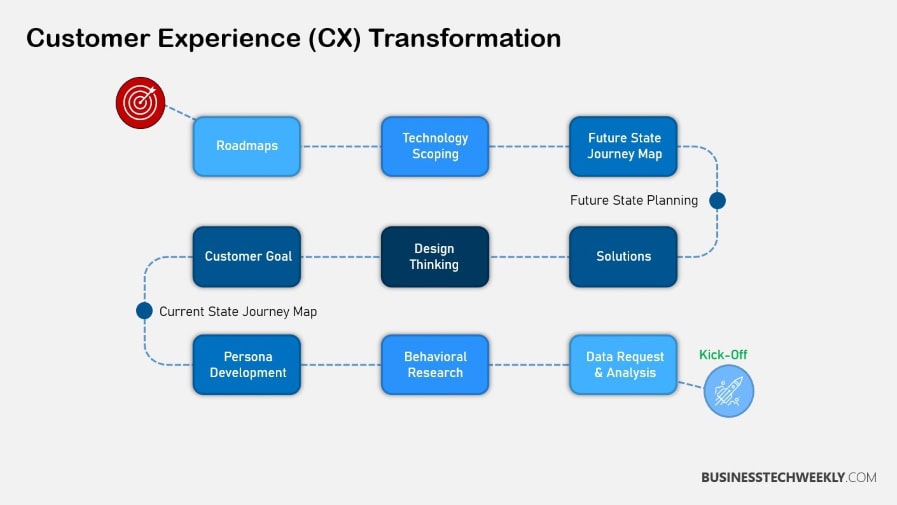
Leveraging Technology for CX Success
Finding and leveraging the right technology solutions can make or break customer interactions and experiences. Now imagine a future where companies are using platforms that were designed from day one with an omni-channel strategy. Your customer can even pause an interaction on one channel.
They can then easily pick up where they left off in another, greatly enhancing their experience between digital channels. Insurers can leverage technology to create more customized policies and a smoother claims process.
This methodology also enables them to provide 24/7 customer support, increasing customer satisfaction and loyalty.
As we know, in this brutally competitive world, where experiences are increasingly the competitive differentiator, technology is becoming critical to business success.
Utilize Advanced Data Management
Having robust data management practices is critical to making sure you have the right and easily accessible information on your customers. Smart use of customer data leads to more informed decisions and more optimized experiences.
As an example, a strong asset management system lays the groundwork for advanced, personalized marketing, increasing customer engagement and bolstering public support.
Of course it’s important to use insights in a way that complies with data protection regulations.
This delicate dance is what empowers businesses to deliver the personalized experiences customers crave, creating brand loyalty and retention in the process.
Implement AI and Machine Learning
Intelligent AI-driven solutions supercharge customer service productivity. To illustrate, AI-driven chatbots and virtual assistants can provide instant assistance and information, improving service efficiency and responsiveness.
Machine learning algorithms can help analyze this data to better predict customer behaviors, allowing companies to engage proactively.
Periodic review of AI applications helps make sure they are truly enhancing customer experiences, helping companies stay one step ahead in the digital race.
RELATED: Why use Chatbots? 5 ways Chatbots can help deliver Business Success
Adopt Emerging Technologies
Keeping an eye on other emerging technologies such as augmented reality and voice recognition, which can create impactful customer experiences. Implementing and experimenting with these innovative solutions unlocks new opportunities to engage with residents.
Understanding their impact allows businesses to proactively shape experiences and avoid conflicts between what they deliver and what customers expect.
Partnering with technology innovators to pilot advanced solutions even further multiplies customer experience, driving innovation beyond what’s currently possible.
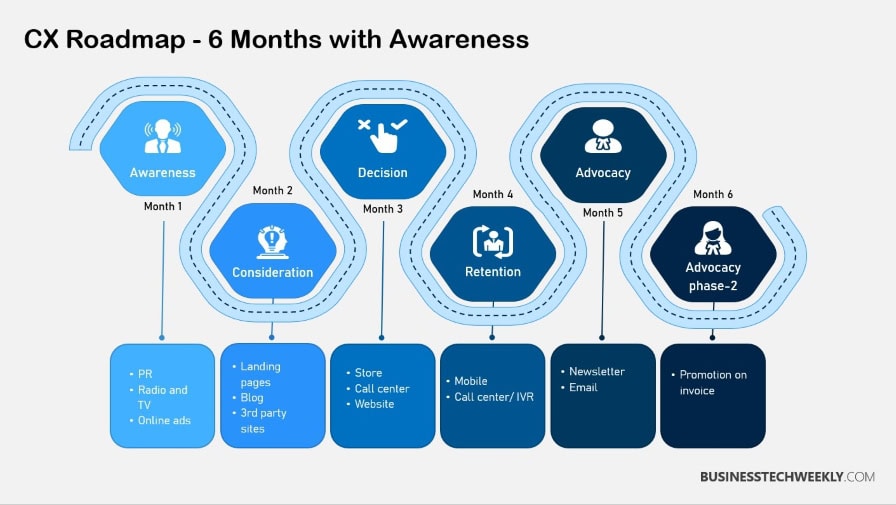
Measuring and Improving Customer Experience
In order to consistently work to improve customer experience on a grand scale, we need to build a holistic framework that measures performance everywhere customers interact with us. Pinpoint the most important touchpoints customers have with your company.
These touchpoints span any channel, from digital to face-to-face experiences to omnichannel journeys.
By identifying and mapping out these touchpoints, you can begin to measure, in a more systematic way, the degree to which your team fulfills customer needs and expectations. Customer satisfaction surveys and Net Promoter Scores (NPS) allow you to measure the likelihood of your customers recommending your service to others.
These tools provide you with the ultimate litmus test for your success. NPS makes your strengths jump off the page.
More importantly, it identifies where change is needed, which makes it critical to changing customer experience (CX) for the better.
Define Key Performance Indicators
In order to measure customer experience effectively, it’s important to first lay out Key Performance Indicators (KPIs) that support your CX objectives. These should be things like customer satisfaction scores, retention rates, and engagement levels.
Measuring and tracking engagement is important to know how often customers are engaging with your brand. At the same time, your retention rates are a measure of how well you’re keeping customers returning for more.
By regularly reviewing these KPIs, you can better understand the impact of your CX initiatives.
This lets you refine your strategies and continue improving customer experience.
Establish Feedback Mechanisms
Developing various channels for customer feedback is essential to gauging customer experience and perception. Whether via surveys, interviews, or focus groups, collecting qualitative data and understanding the customer experience can shine a light on what’s working and what isn’t.
Since 80% of Gen Zers and 78% of millennials are already actively taking surveys, it’s time to make the most out of these tools. By analyzing feedback in a systematic way, we’re able to identify universal trends and areas where we can improve.
Collaboration among teams through shared insights creates an organization-wide culture of continuous improvement.
Finally, it serves to reassure customers that their feedback is leading to real improvements.
Continuously Refine CX Strategies
By making an iterative approach to customer experience transformation strategy a core part of your process, you’ll help future-proof your business against the evolution of customer expectations.
By consistently measuring what you’re doing, proactively identifying issues, and adapting accordingly, you’ll be able to remain lean and nimble in a fluctuating environment.
Fostering a culture of experimentation and innovation opens the door to new ideas, approaches, and ways of thinking, which can support ongoing CX improvements. Yet only 15% of consumers feel like brands are doing a good job with personalization.
This shows the opportunity to improve strategies and more successfully address customer needs and desires. Nearly half of customers are willing to pay more for better service, underscoring the value of refining your CX approach.
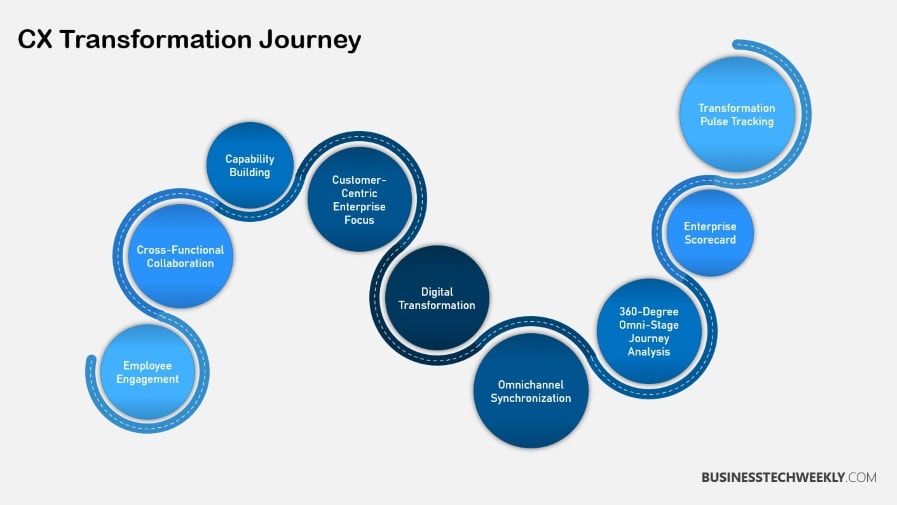
Overcoming Challenges in CX Transformation
Transforming customer experience (CX) is no walk in the park. You’re up against the usual suspects, such as change management, resource prioritization, and evolving with your new customer base. Recognizing these challenges sets the stage for a winning CX transformation.
Companies are scrambling to keep up with ever-increasing expectations. We all see that customer experience (CX) is finally having its moment and poised to become the new brand battleground, overtaking price and product by 2020.
Manage Resistance to Change
Resistance to change is a challenge most organizations face. Communicating the value of CX transformation is crucial. Moving people past their worries starts with addressing them.
When you put the benefits front and center, your team will be better positioned to recognize the value.
Customer loyalty and a competitive advantage will appeal to their sensibilities.
Including employees in the process creates ownership, causing them to be more inclined to embrace changes. Comprehensive training and ongoing support are critical to ensure employee buy-in and help staff adjust to new processes and technologies.
Recognizing those early successes helps create positive momentum, while illustrating that all the effort will lead to positive outcomes.
Allocate Resources and Budget Wisely
Ensuring the right allocation of resources is key. First, make a realistic inventory of what it will take to transform successfully.
Making a budget that is in line with your strategic priorities makes sure that the resources go to the right place. Tracking allocation ensures that the implementation stays on course.
Flexing budgets to both performance and new opportunities is key to continued success beyond the test.
Adapt to Changing Customer Needs
Meeting their evolving expectations doesn’t happen overnight — or even in a single CX transformation cycle. By staying attuned to these changes through research, you position yourself to be more responsive.
By implementing agile strategies, you can pivot quickly. Talking with the people you serve provides keen insight into their evolving needs and expectations.
This strategy leads to a culture of innovation, which leads to proactive solutions to their feedback.
Key Points to Consider
When you dive into customer experience transformation, the wins are huge—both for your customers and for your business.
You also build trust with your customers when you give them a place to feel valued and heard. This kind of loyalty-building effort also enhances your brand’s reputation.
By harnessing the true potential of technology, you transform those important interactions into effortless, enjoyable experiences.
- Customer experience (CX) transformation is more important than ever if companies want to exceed changing consumer expectations and remain competitive. By providing a more seamless experience at every customer touchpoint, organizations can build customer loyalty and stand out from the competition.
- Aligning CX strategies with these larger business goals is essential to ensuring strategies are cohesive and maximizing their impact. By prioritizing customer experience transformation, you’ll increase customer satisfaction and improve retention. This strategy, in turn, leads to positive word-of-mouth and referrals, propelling your bottom line.
- Today’s businesses need to put CX at the center of their strategy if they want to succeed in the digital economy. Social media and online reviews significantly influence customer perceptions, and adapting to these dynamics is essential for maintaining a positive reputation.
- Implementing Customer experience (CX) transformation requires evaluating current experiences, setting clear objectives, and gaining leadership support. A customer-centric culture and detailed journey maps can guide improvements and innovations in service delivery.
- Using technology, like AI and intelligent data orchestration, make experiences more meaningful and seamless. With the help of AI, these tools can help create highly personalized experiences, making customer service faster, more efficient, and more responsive.
- Ongoing measurement and refinement of CX strategies are required to meet evolving customer needs and expectations. Creating pathways for feedback and identifying key performance indicators allows for continuous improvement and encourages a culture of experimentation.

